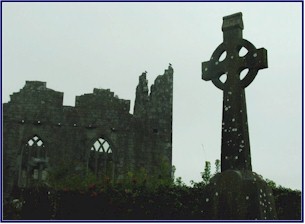Ireland, July 2002 -
continued.
Day
6
Unfortunately, when we woke up, it
was overcast and rainy. Patty
and I went out before breakfast to try to find the stone circle
in the rain. We never
found it, but we had a lovely hike anyway.
The way to the stone circle starts with a climb over a
narrow stile to cross a wire fence, and the only marking at the
head of the trail is “Stone Circle” and a crude arrow
scribbled in ballpoint pen on the wooden stile.
The path then winds over creeks and through fields and
trees and sheep. The
path was very faint, and often hard to follow through the high
heather and gorse. All
in all, it looked like a great place for Leprechauns.
We walked for about a mile, occasionally seeing small signs
pointing the way, but with no indication of how far away the stone
circle was. Eventually
we gave up, as it could have been a five-mile hike for all we
knew, and we were due back shortly for breakfast. We were drenched by the time we made it back to the house.
Stone
circles are ancient arrangements of standing stones that date back
to the earliest of history. I
think many of them were put there by the Druids, some of them are
said to be from before the time of Christ.
They are thought to be places of religious ceremony and
ritual, but nobody really knows exactly when and why they were
built. The most
famous of these is of course Stonehenge, in England, but there are
many smaller such circles all over Ireland.
Finding them can be a challenge!
After
breakfast, we drove back into Kenmare, and then followed the small
coastal road towards Sneem. We
saw a field of cattle, with a sign on the gate that said,
“Beware of Cross Bull”.
|
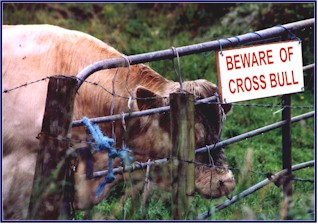
Cross Bull
|
We were searching for the castle we had seen the evening
before from the boat, the one that somebody was supposedly living
in. Sure enough,
before long, we came to a driveway entrance that was very
impressive, with a huge stone gateway and a charming gatehouse.
We figured this must be the place!
We turned down the driveway, and followed a narrow gravel
lane full of potholes for about a mile, and we came out to a
magnificent castle house. It was not an old castle, as castles go, built maybe three or
four hundred years ago. It
looked like somebody had been living in it, but now it was empty,
because it was being renovated and refurbished.
We could not go inside, as it was private property, and of
course we respected the owner’s privacy.
Also, because it was locked!
But we walked around the outside and peered in the windows
the best we could. It
was tall and grand, a very imposing residence, with a moat around
it. Huge old trees
surrounded it, and there were the remains of an old formal garden
in the back, overlooking the water.
We followed the coastline around past Castle Cove.
The day was cloudy, with a light rain falling at times, so
the visibility was not great.
This was a little disappointing, because everyone had told
us that the key to seeing Kerry was to have good weather, but it
really wasn’t too bad. At
least it wasn’t foggy, like it sometimes gets there, where you
can hardly see the road in front of you.
The shoreline and water were beautiful, and we had some
terrific views, but we could not see the mountains in the distance
like we would have on a clear day.
We
did see a lot of sheep. There
were sheep on the steep hillsides, there were sheep in the road,
there were sheep everywhere.
Patty kept trying to touch a sheep out of the car window,
but they weren’t cooperating.
Part
of the time we were driving right along the water, and other times
we were farther inland. When
we were a bit farther from the shore, we passed peat bogs.
These are huge fields and bogs where the surface of the
ground is made of peat, which is harvested and used as fuel to
burn in fireplaces. I am not exactly sure what peat is, but I am pretty sure it
has something to do with the decay of organic matter, and that it
takes centuries to form. The
ground looks very black in these areas, and they remove strips
about three feet deep from the ground.
There were piles of the harvested peat along the side of
the road, set out to dry.
We
drove out to the point of a narrow peninsula called Lamb’s Head.
We were right along the water here, and the land consisted
of huge outcroppings of stone, with green grass all around them.
And of course, sheep.
In fact, some of these sheep had the longest wool I had
ever seen!
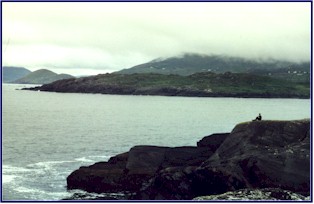
On Lamb's Head |
The road climbed to a high overlook above the water, where
the view was spectacular. We
stopped there to enjoy the scenery; the land was laid out below us
like a patchwork quilt of green.
Small farms, fields lined with hedges and walls of stone,
and cottages by the sea stretched before us.
Far below us in the valley, we could see something round,
built of stone. It
apparently was some type of ruin or fort, and it looked like there
was a small lane near it, so we decided to visit it.
This proved more difficult than we expected!
First
of all, we had a hard time finding the road that led toward it.
After a while, we found the road, it followed a circuitous
route along the shore and through the rolling valley.
The lane got more and more narrow, and turned to gravel and
mud. Before long, it
proved to be the smallest road we had been on yet!
I was a bit nervous about whether the road would just end
with no place to turn around, this happened to me in Connemara
last year. But
eventually, it did lead to the circle of stone we had seen from
the hill. It turned
out to be what they call a Stone Fort.
It consisted of a very sturdy stone wall, perhaps twelve
feet thick and eight to ten feet tall, with grass growing on the
top, built in a circle about sixty feet across.
There were stone steps and ledges all around the inside,
where defenders could stand to fight or shoot arrows.
There were the foundations of several circular houses
enclosed within the fort.
|
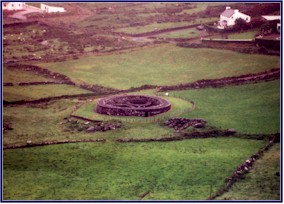 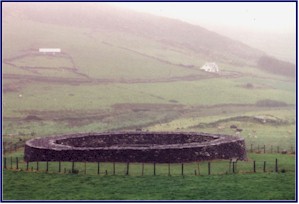
The Stone Fort
|
These Stone Forts in Ireland were built for protection from
enemies, like castles, but much earlier.
This one had an information plaque, telling that it was
built in the 800’s. Wow,
the 800’s! Can you
imagine? It is just
an incredible feeling, to stand in a place like that, and realize
that it was built almost seven hundred years before Columbus
discovered America!
Once
again, we found it really surprising and interesting how Ireland
has ancient antiquities like this, that are open to the public,
but almost nobody knows about them. We discovered this fort because we saw it in the distance
from the overlook; and it was a fascinating adventure to explore
until we found it. But
most people wouldn’t have bothered, and it is not found in any
of the brochures or maps. I guess they have so many ancient relics like this that they
are not considered a big deal!
We really enjoyed the scenery along the drive.
With the mist-shrouded mountains on one side and the
shoreline on the other, it was spectacular in an almost surreal
fashion. The
landscape varied quite a lot as we progressed around the Kerry
Peninsula; in places it was very rugged, rocky, and wild looking,
and in other areas there were farms, cottages and charming little
houses, very well-kept, with the gardens and yards full of
flowers. Sometimes
the road was fairly wide and fast, then suddenly it would narrow
down to a small and twisty lane.
Everywhere we saw pastures of lush green divided by hedges
and fences of stone. It had rained quite a bit over the preceding days, so the
streams were full, and we saw several lovely small waterfalls.
Fuchsia plants were growing wild and blooming everywhere,
often there were whole hedgerows of them in full blossom.
|
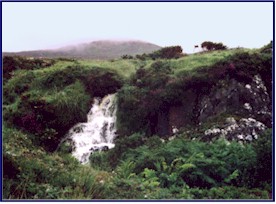
Kerry Waterfall
|
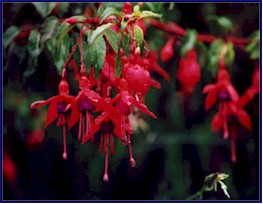
Fuchsia
|
After passing through Waterville, we again went off the
beaten path, following the shoreline of the Portmagee Channel to
the end of the peninsula, where we then took the bridge over to
Valencia Island. In
this area, we could see beautiful cliffs overlooking the water.
The island was mostly farmland, and we drove along a high
ridge where at times, you could look down and see water on both
sides. At the
Valencia Harbour, we took the ferry back over to the mainland, and
from there went in search of our B&B.
Before
leaving home, I had cleverly printed out directions to all of our
B&Bs. Very
organized, don’t you think?
Unfortunately, I had neglected to bring those directions to
Ireland with me! So
we had to go by trial and error to find our lodging.
My theory was that we could stop by any B&B in the area
and ask the way to Mrs. McCrohan’s Farmhouse; they would
probably all know one another. Unfortunately, this didn’t prove to be true, and at the
first place we stopped to ask, we met a witch.
She was probably a very nice witch, but nonetheless, we
could well imagine her with her coven, chanting incantations at
some stone circle in the twilight.
Patty and I distracted her by borrowing her phone, while
Mom stole a rose from her garden.
Actually, on our second try, we
did find someone who knew where our lodging was, and we soon
checked in to Mrs. McCrohan’s Farmhouse B&B, in Caherciveen.
Mrs. McCrohan couldn’t have been nicer, and the house was
charming; it was on a working dairy farm, right by the sea.
Mrs.
McCrohan was a good source of information, and she told us about
yet another of those fabulous castles that only the locals know
about. This one was
called Ballycarbery Castle, and we set out to explore it before
dinner. There was a
little lane that went fairly close to it, but then we saw a gap in
the fence, so I was able to drive our little purple humvee right
up beside the castle so that Mom wouldn’t have too far to walk.
Ballycarbery Castle was another fabulous place.
It is a medium large castle, with most of the rear wall
gone. We could
explore different rooms and chambers, and climb the winding
staircases. Once
again, Mom climbed right up to the top levels of the castle,
despite the difficult and treacherous stone steps.
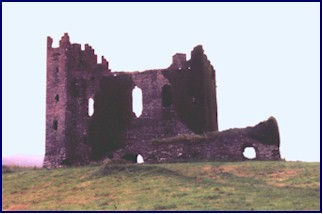
Ballycarbery Castle |
The castle walls were over eight feet thick, and there was
a secret tunnel at the bottom of one of the side turret walls that
led to an enclosed chamber that must have been a dungeon.
One side of the castle was almost completely covered by a
huge tree of ivy. We
reached into several holes and small hidden compartments in the
thick walls, but there was no Chalice to be found.
You could close your eyes and imagine the castle, as it
once must have been, with bright banners flying overhead and
knights riding in through the front gate.
Next we found our way to the Leacanabuaile Stone Fort.
When we got to the small pullover parking area for the
fort, we saw it was quite a walk up to it, too far for Mom to want
to walk, plus it was raining, and getting dark.
So Mom suggested that we drive right up to the fort, as we
had to the castle. The
only problem was, the gate was shut, the lane was narrow and
muddy, and it looked like there was probably no place to turn
around. Oh, and also,
it was almost certainly against the law.
Other that that, it sounded like a great idea, so Patty
unscrewed the bolt on the gate to let us drive in, and up the lane
we slithered and squelched, dragging bottom on every rock, and
finally coming to a standstill with spinning wheels, to find that
indeed, not only was there no place to easily turn around, but
that we were stuck in the mud.
It was at that moment that I first observed that our
intrepid little purple humvee had really itty bitty little tires,
and there wasn’t all that much air in them, either.
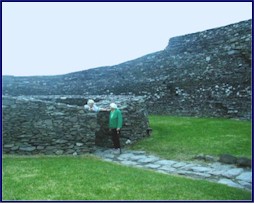 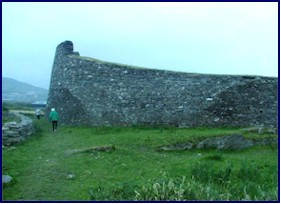
Leacanabuaile Stone Fort |
The
Leacanabuaile Stone Fort itself was really cool.
It was similar to the one we had discovered from the
overlook the day before, but much larger and the walls were
higher, probably 15 to 20 feet tall. Like the other fort, this one was built for protection,
sometime in the ninth century.
Mom climbed up the inside wall on the narrow open sided
rock ledge stairways, so that she could look out over the top.
She found that it was a little harder coming down than
going up!
When
we were ready to go, we managed to unstick the gallant purple
rental car (Patty got out and pushed) and turn it around.
Fortunately we exited the farm lane without being arrested
or losing the oil pan. Definitely, getting there had been half the adventure!
We went to dinner in Caherciveen, at a restaurant called
QC’s. It had a
pub-like atmosphere, but specialized in some of the best seafood
we had found yet. We
had the crab, which was excellent, and Patty loved the sautéed
baby squid. Yuck!
Day
7
I have decided what I will do for
my next career. I am
going to write a book, a guide to all of the castles in Ireland.
There is plenty written about the large and famous castles,
such as the Rock of Cashel, Cahir Castle, or Blarney.
But the country is full of other castles, many of them
small ‘everyday’ castles on private land or in pastures.
They are rich with history, the heritage of this wonderful
country, but many of them are unknown, or hidden, or forgotten. I will spend years doing research for this book, driving up
every little road and lane in searching for them, not to speak of
the research that can be done in the pubs!
I will find every castle in the whole country!
I will photograph each one, and write descriptions and
directions. The only
drawback to this new ‘career’ is that I may starve, because I
don’t know who would buy such a book; but I will sure have fun
researching it!
This was the day that we went through the mountains.
From Caherciveen, we headed back south towards Waterville,
and then turned up into the mountains on a little tiny road that
ran along the River Inny. We followed this river up into the Ballaghisheen Forest, and
then up over a mountain pass.
We passed quite a lot of logging operations in the forests. Because Ireland is an island, without a lot of forestland,
they manage the harvesting of the trees very carefully, always
replanting the forests after they remove the timber.
The
scenery through the mountains was beautiful, even though it was an
overcast day, and the visibility was not all that we had hoped
for. There was again
a fine mist or light drizzle, and when we got to the very top of
the mountain, at the overlook, we were enveloped in a cloud!
We found our way down to the town of Glencar. Actually, Glencar consisted of one building, which was both a
lodge and a post office. Navigating
the small unmarked roads was a fun challenge.
We found our way around to Carragh Lake, where we drove
right along the shore. It
was stunning! This
was the route that Chris Ryan had told us about, and his
recommendations were definitely good ones!
At one point, we came across a small herd of cattle in the
middle of the road. There
were several pasture gates standing open, and about a dozen cows
and calves were wandering aimlessly in the roadway. About twenty more were slowly meandering through their
pasture toward the open gate leading onto the road.
We were worried that they might cause an accident, so we
decided to try and remedy the situation.
Patty got out of the car and herded the cattle out of the
road, talking sternly to them all the time.
They seemed to respond well to her admonishments, and soon
she got them back where they belonged, and shut the gate.
At least we hoped it was where they belonged, but we
weren’t really sure, as we passed several different pastures
with gates sitting open. For
all we know, we may have put a prize herd in the wrong field and
started a blood feud that would last for generations, based on
suspicion of cattle theft!
From Carragh Lake, we continued on to the town of
Killorglin, where we had lunch, and then on past the Castlemaine
Harbour. From there,
we took another very small road over a mountain pass on the way to
Tralee; it was quite lovely, even though the visibility wasn’t
great. From up on the
mountainside, we could look back towards the water, and the whole
valley was laid out like a green patchwork quilt before us.
We passed a high valley of peat bogs, and of course, more
sheep. In fact, Patty
finally managed to touch a sheep!
I am not sure how she got it to stand still for her, but
after the conversation with the cows, I realized she could be very
persuasive.
After passing Tralee, a good-sized town where we got stuck
in traffic, we continued on north past Abbeydorney.
Mom finally found her dogs!
We passed a house with a litter of half grown greyhounds
lounging around in the yard.
They were shy but friendly, and really quite sweet!
We found their owner and asked if they were for sale.
He said yes, he would sell them, but he wanted 2000 quid
each. We weren’t
sure just how much a quid is, but we were pretty sure that 2000 of
them was more than we were willing to pay!
After
several wrong turns, we located the Rattoo Round Tower.
This was a tall cylindrical tower, much like a lighthouse
in shape, with the remains of an Abbey beside it.
The tower was built as a lookout post, and dated from
around 1100.
|
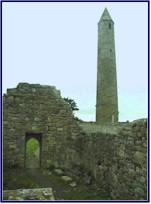 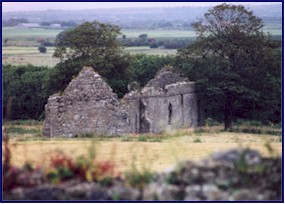
Rattoo Round Tower and
Abbey
|
We
took a little side trip to the town of Ballybunnion, which is
right on the sea. The
Ballybunnion Castle sits on a cliff on the edge of the ocean, but
there is not much left of it, just a couple of walls. There was quite a nice big sandy beach below the castle.
There were a lot of people down by the water, but few went
in to swim; it was really rather cold for beach weather!
I think the highest the temperature ever got during our
entire trip was about 70 degrees, quite a pleasant break from the
heat and humidity of Virginia in July.
We continued on to find our B&B, which was called
Castle View. It was
so named because it has a great view of the Carrigafoyle Castle.
Once again, not having my directions to our lodging, we had
to wing it, but I figured if we found Carrigafoyle Castle, the
B&B would be in sight. This
worked well, but to our dismay, when we found the castle, it was
covered with a huge blue shroud!
The castle was being renovated, so there was scaffolding
all around it, and huge blue sheets of tarps for protection.
Patricia
and Garrett Dee run the Castle View House, our B&B, and it is
quite lovely. It sits on an island, right on the river, with a lovely view
across the water to the nearby castle, shrouded in blue though it
was. The Dees fixed us dinner that night so that we didn’t have
to drive back to town, and this was a treat, they are super cooks.
Also, they have the most fabulous rose garden! Mom was in heaven enjoying the roses, and she was busy
getting information from them about some of their special roses.
In fact, the day after Mom returned home, she was
mercilessly pruning back her own roses, to make her garden look
more like the one at Castle View!
After dinner, we went to visit the castle.
Carrigafoyle Castle turned out to be really lovely.
Or at least, we could tell that it would have been, if it
weren’t covered in blue tarps!
It sits on a low island of sorts in the Shannon River, but
during high tide, the castle is actually in the water.
There is an old church near it, in a cow pasture.
The
castle is closed to the public during the renovations, but we
could see in the doorway. It turns out that Garrett has been very
instrumental in bringing about the restoration of the Carrigafoyle
castle and we were glad that it was being renovated, as many of
Irelands castles are deteriorating and falling into disrepair.
But we were also disappointed not to be able to see it
properly or to go inside.
It is quite a lovely castle, with steps up to the top
floors; it will be well worth going back when the repairs are
finished. I will need to revisit it anyway, to include it in my castle
book!
We
then went into Ballylongford, where we visited an old church ruin
with an active graveyard. Then, sorry that we would be leaving Ireland to return home
the next day, we returned to the Castle View and to bed.
Day
8
When we got up in the morning to
go to the airport, it was a beautiful day, the sun was shining and
the sky was blue! Very
frustrating, we wished we had that kind of weather driving over
the mountain passes the last two days!
On the way to the airport, we passed an especially nice
‘everyday castle’. It
was in the middle of a field of cows, and the whole side of it was
covered in ivy. This
is just the sort of hidden or unknown castle that my book will
feature!
Our trip home did not go smoothly.
First, our plane from Shannon to Heathrow was late, so by
the time we arrived in London, we had already missed our flight
home. United Airlines
then put us on a plane to Chicago, where we were to catch a flight
home to Dulles. But
after rushing to catch this flight, the plane sat on the runway
for an hour and forty-five minutes due to thunderstorms before it
took off. So by the
time we arrived in Chicago, we had again missed our connection
flight! We got to
spend the night in Chicago, which was no thrill.
In fact, I went down to our hotel’s restaurant to bring
back some food for us to eat in the room, and on my return, I
found a sign on the door that read, “Beware of Cross
Travelers”!
All in all, it was another great trip. I
love visiting Ireland, but to get the chance to travel there with
Mom and Patty made it all the more special.
I would have gladly stayed another week!
And I already have destinations planned out for the next
time I go back!
|
